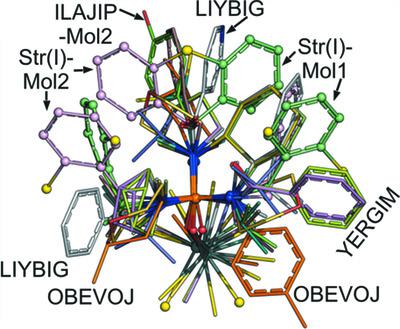当前位置:
X-MOL 学术
›
Acta Cryst. C
›
论文详情
Our official English website, www.x-mol.net, welcomes your
feedback! (Note: you will need to create a separate account there.)
Conformational analysis of two new organotin(IV) structures completed with a CSD survey
Acta Crystallographica Section C ( IF 0.7 ) Pub Date : 2021-01-14 , DOI: 10.1107/s2053229620016502 Fahimeh Sabbaghi , Azam As'habi , Anahid Saneei , Mehrdad Pourayoubi , Abdul Ajees Abdul Salam , Marek Nečas , Michal Dušek , Monika Kučeráková , Sudarshan Acharya
Acta Crystallographica Section C ( IF 0.7 ) Pub Date : 2021-01-14 , DOI: 10.1107/s2053229620016502 Fahimeh Sabbaghi , Azam As'habi , Anahid Saneei , Mehrdad Pourayoubi , Abdul Ajees Abdul Salam , Marek Nečas , Michal Dušek , Monika Kučeráková , Sudarshan Acharya

|
The conformational flexibilities are studied in two new organotin(IV) complexes, namely, trans‐dichloridodimethylbis[N,N′,N′′‐tris(2‐chlorobenzyl)phosphoric triamide]tin(IV), [Sn(CH3)2(C21H21Cl3N3OP)2Cl2] or Sn(CH3)2Cl2{OP[NHCH2C6H4(2‐Cl)]3}2, (I), and bis(dipropylammonium) tetrachloridodimethylstannate(IV), [(CH3CH2CH2)2NH2]2[Sn(CH3)2Cl4], (II), and their analogous structures from the Cambridge Structural Database (CSD). The conformations are considered based on the N—P=O—Sn torsion angles for (I) and the C—C—C—N, C—C—N—C, C—N—C—C and N—C—C—C torsion angles for the two symmetry‐independent [CH3CH2CH2NH2CH2CH2CH3]+ cations in (II), and the ±ac±sp±ac (ac = anticlinal and sp = synperiplanar) and ±ap±ap±ap±ap (ap = antiperiplanar) conformations are observed, respectively. In both structures, the four atoms in the corners of the square‐planar segment of the octahedral shape around the Sn atom participate in normal hydrogen‐bonding interactions as acceptors, which include two O and two Cl atoms for (I), and four Cl atoms for (II). However, the phosphoric triamide ligands block the environment around the Sn atom and limit the hydrogen‐bond pattern to form a supramolecular ribbon assembly, while in the presence of small organic cations in (II), a two‐dimensional hydrogen‐bonded architecture is achieved. The weak interactions π–π, C—H…π and C—Cl…π in (I), and C—H…Cl in (II) do not change the dimensionality of the hydrogen‐bond pattern. The 62 CSD structures analogous to (I), i.e. with an SnOPN3 segment (including 83 entries) fall into four categories of conformations based on the N—P=O—Sn torsion angles. The 132 [(CH3CH2CH2)2NH2]+ cations from 85 CSD structures are classified into seven groups based on the torsion angles noted for (II). Most of the CSD structures adopt the same associated conformations noted for (I) and (II). 15 [Sn(CH3)2Cl4]2− anions extracted from the CSD are compared with the structure of (II).
中文翻译:

通过CSD调查完成的两种新型有机锡(IV)结构的构象分析
研究了两种新的有机锡(IV)配合物的构象柔韧性,即反式-二氯代二甲基双[ N,N ',N ''-三(2-氯苄基)磷酸三酰胺]锡(IV),[Sn(CH 3)2(C 21 H 21 Cl 3 N 3 OP)2 Cl 2 ]或Sn(CH 3)2 Cl 2 {OP [NHCH 2 C 6 H 4(2-Cl)] 3 } 2,(I)和bis(二丙基铵)四氯化二甲基锡酸酯(IV),[(CH3 CH 2 CH 2)2 NH 2 ] 2 [Sn(CH 3)2 Cl 4 ],(II)及其来自剑桥结构数据库(CSD)的类似结构。基于(I)和CCCN,CCNC,CCNCC和NCC的NP = O-Sn扭转角来考虑构象。对于两个对称独立[CH C-C扭转角3 CH 2 CH 2 NH 2 CH 2 CH 2 CH 3 ] +分别观察到(II)中的阳离子,以及±ac±sp±ac(ac =背斜,sp =上平面)和±ap±ap±ap±ap(ap =上平面)构象。在这两种结构中,围绕Sn原子的八面体形状的方形截面的角上的四个原子均作为受体参与正常的氢键相互作用,其中包括两个O和两个Cl原子用于(I),四个Cl (II)的原子。然而,磷酸三酰胺配体阻止了Sn原子周围的环境并限制了氢键模式以形成超分子带状组装体,而在(II)中存在小有机阳离子的情况下,实现了二维氢键结构。(I)中的弱相互作用π–π,CH–H…π和C–Cl…π,以及(II)中的CH–H…Cl不会改变氢键模式的维数。即,具有SnOPN 3片段(包括83个条目)基于NP = O-Sn扭转角可分为四类构象。根据(II)记下的扭转角,将来自85个CSD结构的132个[(CH 3 CH 2 CH 2)2 NH 2 ] +阳离子分为七个组。大多数CSD结构采用与(I)和(II)相同的相关构象。将从CSD提取的15 [Sn(CH 3)2 Cl 4 ] 2-阴离子与(II)的结构进行比较。
更新日期:2021-02-04
中文翻译:

通过CSD调查完成的两种新型有机锡(IV)结构的构象分析
研究了两种新的有机锡(IV)配合物的构象柔韧性,即反式-二氯代二甲基双[ N,N ',N ''-三(2-氯苄基)磷酸三酰胺]锡(IV),[Sn(CH 3)2(C 21 H 21 Cl 3 N 3 OP)2 Cl 2 ]或Sn(CH 3)2 Cl 2 {OP [NHCH 2 C 6 H 4(2-Cl)] 3 } 2,(I)和bis(二丙基铵)四氯化二甲基锡酸酯(IV),[(CH3 CH 2 CH 2)2 NH 2 ] 2 [Sn(CH 3)2 Cl 4 ],(II)及其来自剑桥结构数据库(CSD)的类似结构。基于(I)和CCCN,CCNC,CCNCC和NCC的NP = O-Sn扭转角来考虑构象。对于两个对称独立[CH C-C扭转角3 CH 2 CH 2 NH 2 CH 2 CH 2 CH 3 ] +分别观察到(II)中的阳离子,以及±ac±sp±ac(ac =背斜,sp =上平面)和±ap±ap±ap±ap(ap =上平面)构象。在这两种结构中,围绕Sn原子的八面体形状的方形截面的角上的四个原子均作为受体参与正常的氢键相互作用,其中包括两个O和两个Cl原子用于(I),四个Cl (II)的原子。然而,磷酸三酰胺配体阻止了Sn原子周围的环境并限制了氢键模式以形成超分子带状组装体,而在(II)中存在小有机阳离子的情况下,实现了二维氢键结构。(I)中的弱相互作用π–π,CH–H…π和C–Cl…π,以及(II)中的CH–H…Cl不会改变氢键模式的维数。即,具有SnOPN 3片段(包括83个条目)基于NP = O-Sn扭转角可分为四类构象。根据(II)记下的扭转角,将来自85个CSD结构的132个[(CH 3 CH 2 CH 2)2 NH 2 ] +阳离子分为七个组。大多数CSD结构采用与(I)和(II)相同的相关构象。将从CSD提取的15 [Sn(CH 3)2 Cl 4 ] 2-阴离子与(II)的结构进行比较。











































 京公网安备 11010802027423号
京公网安备 11010802027423号